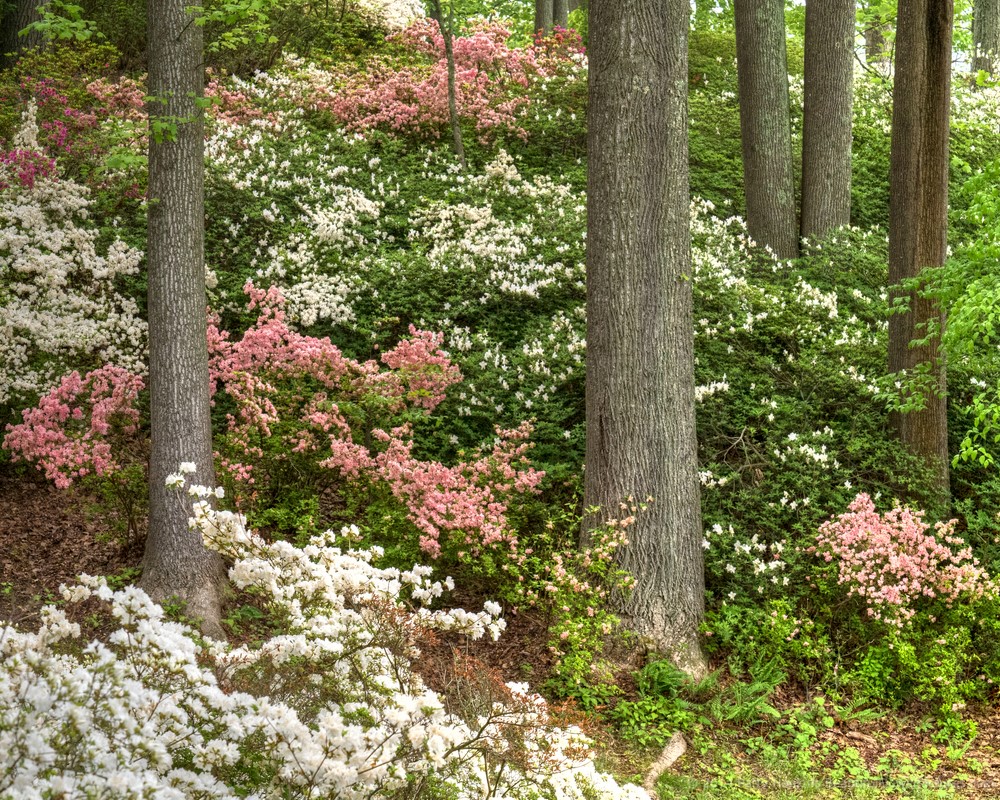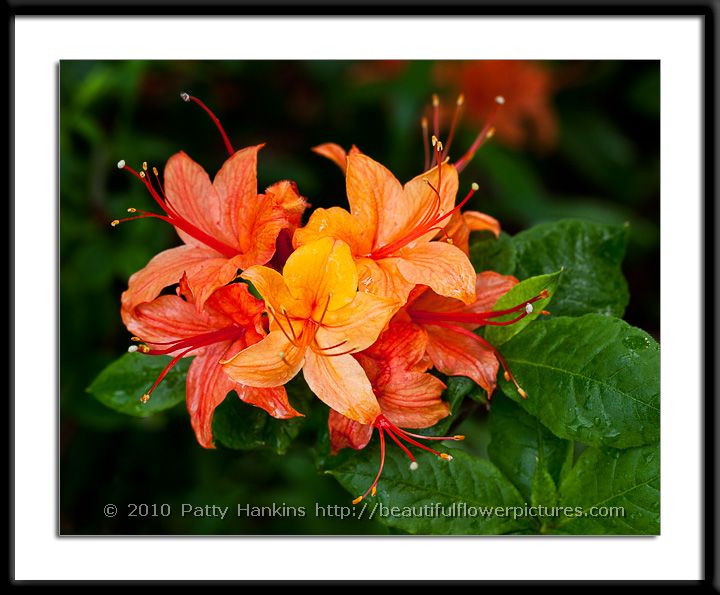
by hankinslawrenceimages | Jan 19, 2015 | Ericaceae Family, Flowers, New Photos

Azaleas Among the Trees ○ 2014 Patty Hankins
I’ve recently added a new photo – Azaleas Among the Trees – to my BeautifulFlowerPictures.com website.
Every spring I try to visit the Azalea Garden at Brighton Dam in Brookville, Maryland. It’s one of the true hidden treasures in the Washington, DC area. The garden, established by the Washington Suburban Sanitary Commission, has over 20,000 azalea bushes that bloom in early May. It’s the only place in the DC area I’ve found where I can wander among full-grown trees and azalea bushes taller than I am, turn a corner and see wonderful scenes like the one I captured in this photo. This was one of my photos from May of 2014 when I had the garden to myself the morning I went out to photograph there on a weekday morning.
This photograph is available as a matted photo. You can order Azaleas Among the Trees from my website.
by hankinslawrenceimages | May 5, 2011 | Ericaceae Family, Flowers
 (c) 2011 Patty Hankins
(c) 2011 Patty Hankins
Each year in late March I’m always surprised to see some rhododendron’s blooming in local botanical gardens. In the DC area, when you think of rhododendrons and azaleas blooming – it’s usually in May and June. So the ones blooming in March really stand out. The early blooming rhododendrons are the Korean Rhododendron (rhododendron mucronulatum).

(c) 2011 Patty Hankins
Korean Rhododendrons are native to Northern China, Korea and Japan. Here in the United States they are hardy from zones 8b to 4a. They prefer growing in sun to partial shade in moist well-drained soil.
 (c) 2010 Patty Hankins
(c) 2010 Patty Hankins
Korean Rhododendron bloom in early to mid spring. They add a wonderful splash of color into the garden at that time of year. In the DC area, they bloom at about the same time as the Yulan Magnolia and Star Magnolias. The flowers emerge on the shrubs before the leaves emerge. Like other decidious shrubs, the Korean Rhododendrons lose their leaves each fall. In the fall, the leaves turn to shades of yellow and red.
 (c) 2010 Patty Hankins
(c) 2010 Patty Hankins
Korean Rhododendron are a slow growing shrub that usually grow to about 4 to 8 feet tall. When full grown, they are 4 to 6 feet wide. The pink/purple flowers bloom in clusters of three or six and are about 1.5 inches in diameter.
 (c) 2010 Patty Hankins
(c) 2010 Patty Hankins
I have photographed Korean Rhododendron in several botanical gardens in the DC area including McCrillis Gardens in Bethesda, Green Spring Gardens in Alexandria and the National Arboretum in DC.
Some websites with additional information about Korean Rhododendron include
Dave’s Garden
NC State University Department of Horticulture
UConn Plant Database
University of Illinois Extension
by hankinslawrenceimages | Nov 6, 2010 | Ericaceae Family, Flowers, New Photos, Wildflowers

Flame Azalea (c) 2010 Patty Hankins
I’ve recently added a new photo – Flame Azalea – to my Beautifulflowerpictures.com website.
Flame Azaleas (Rhododendron calendulaceum) are one of several species of azaleas native to the southeastern United States. I love the bright yellows and oranges in the flame azalea. I photographed this cluster of flame azalea blossoms along the Blue Ridge Parkway earlier this year.
This photograph is available as either a 12X15″ or 20X26″ gallery-wrapped canvas. You can order Flame Azalea from my website and I will have it available at shows.
by hankinslawrenceimages | Jul 11, 2010 | Ericaceae Family, Flowers, Wildflowers
One of my goals for my recent trip to North Carolina was to photograph the Catawba Rhododendron (rhododendron catawbiense) in bloom. From everything I’ve heard, seeing the Catawba Rhododendron in bloom along the Blue Ridge Parkway is sort of like seeing the cherry blossoms in Washington DC – something you really need to see to believe. Unfortunately, while I did find a few rhododendron still blooming, I totally missed the peak Catawba Rhododendron bloom.

(c) 2010 Patty Hankins
The first place I stopped in search of Catawba Rhododendrons was at Craggy Gardens along the Blue Ridge Parkway. I found a few blossoms in not very good shape. The next morning, at Rhododendron Gardens in the Pisgah National Forest, I found a few shrubs with a clump or two of blossoms. From the overlook, I could see the hillside of rhododendron bushes – and could only imagine how it must look at peak bloom.
 (c) 2010 Patty Hankins
(c) 2010 Patty Hankins
Catawba Rhododendron are native to much of the Southeastern United States except for Florida. They grow up to 20 feet tall, with evergreen oblong leaves. Their dark lavender blossoms bloom in clusters in June along North Carolina’s Blue Ridge Parkway. The clusters have 5 to 10 flowers, and are about 6 inches in diameter.

(c) 2010 Patty Hankins
Similar to other rhododendrons, all parts of the Catawba Rhododendron are highly toxic. Do not eat it! It can kill you!
 (c) 2010 Patty Hankins
(c) 2010 Patty Hankins
I’ll admit that I was disappointed to have missed the blooming of the Catawba Rhododendron on this trip. But I did some ideas on where to go back to next year . . . I’ll just head back to North Carolina a little earlier in June next time.
If you’d like to learn more about the catawba rhododendron – some online sites with additional information include
USDA Plant Profile for Rhododendron Catawbiense
Lady Bird Johnson Wildflower Plant Database
U. Conn Plant Database
GRIN Taxonomy for Plants
NC State University Plant Fact Sheets
by hankinslawrenceimages | Jun 9, 2010 | Ericaceae Family, Flowers
One of the biggest surprises of my spring photography was finding a rhododendron in full bloom in March in the Washington, DC area. Usually, the azaleas bloom in April/May – followed by many of the rhododendrons. So you can imagine my surprise to see what was clearly a rhododendron blooming at two different gardens in March.
It turns out – what I was seeing was Korean Rhododendron (Rhododendron mucronulatum). Native to China, Korea and Japan, Korean Rhododendron is an early blooming shrub that is hardy to Zone 4. The showy pink/purple flowers blossom in clusters of three to six flowers. A deciduous shrub, the leaves of the Korean Rhododendron turn yellow/red/orange in the fall before shedding. These shrubs prefer full sun to light shade, usually growing from four to eight feet tall.
The first Korean Rhododendron I photographed this spring was at Green Spring Gardens in Alexandria, Virginia. I really like the way it added a great splash of color to the browns of the woods in early spring.

(c) 2010 Patty Hankins
I really like the way the light was backlighting some of the petals.

(c) 2010 Patty Hankins

(c) 2010 Patty Hankins
A couple of weeks later, I had the opportunity to photograph another Korean Rhododendron at McCrillis Gardens in Bethesda, Maryland.

(c) 2010 Patty Hankins
 (c) 2010 Patty Hankins
(c) 2010 Patty Hankins
Now that I know that Korean Rhododendron bloom in March in the DC area – I’ll definitely keep an eye out for it next year. It’s a wonderful splash of pink that arrives a few weeks before the cherry blossoms bloom.
by hankinslawrenceimages | Jun 6, 2010 | Ericaceae Family, Flowers
This spring, I photographed several beautiful Florida Azaleas as I was visiting North Carolina and Tennessee.
Florida Azaleas (rhododendron austrinum) are one of the fifteen native azaleas that are found in the Southeastern United States. Native to a small region of Florida, Georgia, Mississippi and Alabama, the Florida Azalea are a fragrant, early blooming plant. They usually bloom from late March through late April – at the same time as the Hoary Azaleas (rhododendron canescens). The blossoms on the Florida Azaleas are shades of gold, yellow and orange with long stamens. The rhododendron canescens blooming at the same time are usually in shades of white to pink.
I first photographed the Florida Azaleas at the Bog Garden in Greensboro, North Carolina.

(c) 2010 Patty Hankins

(c) 2010 Patty Hankins
I next found some Florida Azaleas at Reflection Riding Arboretum in Chattanooga, Tennessee. Their plant was labeled, so I was able to identify the type of azalea I had photographed a few weeks previously in Greensboro.

(c) 2010 Patty Hankins
Later in my trip, I photographed another Florida Azalea at the North Carolina Arboretum in Asheville.
 (c) 2010 Patty Hankins
(c) 2010 Patty Hankins
And finally, a Austrinum Gold Florida Azalea (rhododendron austrinum “austrinum gold”) also photographed at the North Carolina Arboretum
 (c) 2010 Patty Hankins
(c) 2010 Patty Hankins
The Florida Azaleas I photographed were all absolutely beautiful plants. I can’t wait to photograph more of them next spring.





















